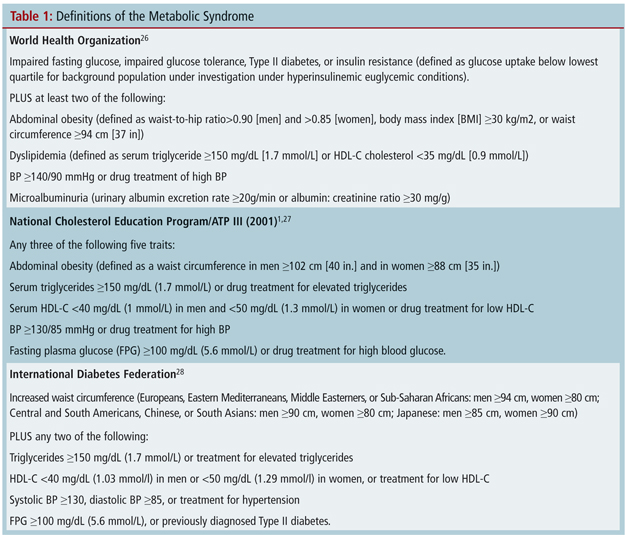The metabolic syndrome, though controversial due to lack of a uniform pathophysiological mechanism, is a useful clinical tool for identifying persons at risk for diabetes and cardiovascular disease. It indicates the cumulative cardiometabolic risk exerted by abdominal obesity, hyperglycemia, high triglyceride, low high density lipoprotein cholesterol (HDL-C), and high blood pressure. Lifestyle factors, high calorie intake, and less physical activity have been implicated in the causation of the metabolic syndrome, and thus older adults are at particular risk for the development of this syndrome. Current evidence indicates that the components of the metabolic syndrome can be targeted with lifestyle interventions to prevent the complications of diabetes and cardiovascular disease. This paper reviews various diagnostic criteria, etiological factors, and lifestyle interventions to combat the metabolic syndrome in order to prevent diabetes and cardiovascular disease in older adults.
Key words: metabolic syndrome, prevention, lifestyle modification, diet, physical activity.
What Is the Metabolic Syndrome?
There is significant variation in the criteria proposed to diagnose the metabolic syndrome (Table 1). The metabolic syndrome, a combination of certain glucose and lipid metabolism-related risks factors for Type II diabetes and cardiovascular disease (CVD) that often co-occur, though controversial due to lack of a uniform pathophysiological mechanism, is a useful clinical tool for identifying the population at risk for Type II diabetes and CVD. The metabolic syndrome is said to exist when any three of the five defined risk factors (abdominal obesity, impaired fasting glucose, elevated triglyceride, low high density lipoprotein cholesterol [HDL-C], and elevated blood pressure [BP]) are present.1 The clustering of cardiometabolic risk factors were termed “syndrome X” by Reaven2 and has been also referred to as dysmetabolic syndrome, insulin resistance syndrome, and deadly quartet. About 47 million Americans have the metabolic syndrome; it affects approximately 45% of individuals over 60 years of age.3
Clik here to view.

What Causes Metabolic Syndrome?
No set of diagnostic criteria identify a uniform physiologic or genetic mechanism explaining the co-occurrence of the risk factors grouped together as the metabolic syndrome. Current evidence indicates that the metabolic syndrome is the result of the interplay of several closely-linked contributing factors, such as genetic predisposition, lack of physical activity, abdominal adiposity, hyperinsulinemia, insulin resistance, a proinflammatory state and stress.4,5,6,7
Contributing Factors to the Development of Metabolic Syndrome Overweight, Obesity, and Lack of Physical Activity
Excess calorie intake and decreased physical activity in addition to age-related changes in body composition (i.e., an increased fat/lean body mass ratio) leads to excess visceral fat deposition in older adults. Abdominal adipose tissue is the largest endocrine organ in the body, and produces resistin, adiponectin, tumour necrosis factor (TNF)-alpha and interleukin (IL)-6, all of which contribute to the development of insulin resistance and metabolic syndrome.4
Insulin Resistance and Hyperinsulinemia
Insulin resistance is caused by decreased tissue uptake of glucose in response to the action of insulin, eventually leading to a compensatory increase in insulin secretion and serum level. This results in hyperglycemia, hypertriglyceridemia, low HDL-C, high BP, and a procoagulant state.1
Stress
Physical or mental stress causes sympathetic stimulation, resulting in norepinephrine and glucocorticoid release, which contribute to hyperglycemia and a proinflammatory state.5
Proinflammatory State
The metabolic syndrome is considered a chronic inflammatory state. Inflammatory markers such as IL-6, TNF-alpha and C-reactive